Connecting a single-phase electric meter and automatic machines: standard diagrams and connection rules
To calculate the consumed electricity and protect the network at most household and residential facilities, it is necessary to connect a single-phase meter and automatic machines. This activity must usually be carried out by the owner of the premises.
If you have a little skill in working with wiring, you can do this work yourself without involving third-party specialists, and we will tell you how to do it.
The content of the article:
Typical single-phase network input circuit
The vast majority of apartments, garden plots and small household facilities such as garages are connected to a single-phase network. The method of connecting the measuring device (electricity meter) and the protective circuit elements (RCDs, circuit breakers and differential circuit breakers) is the same.
Depending on the operating conditions and powered devices, the connection diagram of a single-phase electric meter may undergo the following changes:
- No ground input.
- Lack of an individual input machine in front of the counter. It can be common to several circuits equipped with metering devices, or an ordinary manual switch (switch) can be installed instead.
- No branching into multiple circuits.
- Lack of RCDs and automatic circuit breakers protecting the line after the meter.
If there are no automatic circuit breakers or RCDs between the meter and consumers, then in the event of a short circuit or significant overload, the meter will break down.Therefore, protection is needed immediately after the metering device, especially since the simplest circuit breakers are cheap.
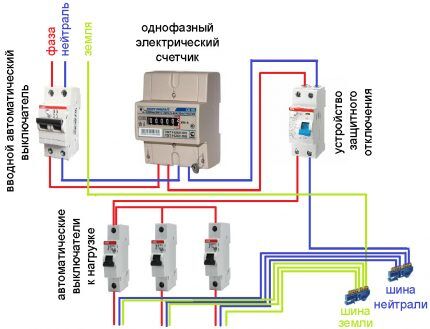
Division of responsibility for electrical appliances
The electrical distribution throughout the facility is protected by separate switches that regulate the maximum permissible current for sections of the circuit. Payment for their purchase and connection is made by the owner of the premises.
The electricity meter and the input machine can be physically located not only in the consumer’s area of responsibility. If these devices are located in a privatized apartment, in a garage, in a utility room or within the boundaries of a cottage or summer cottage, then their installation, maintenance and replacement are carried out by the owner of the property.
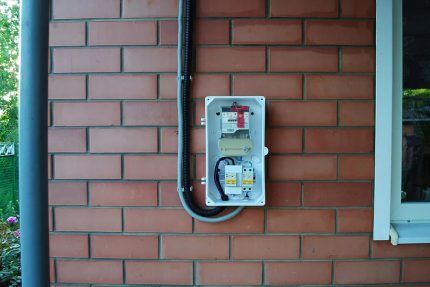
His responsibilities also include providing energy service employees and the management company with access to the meter for reading, sealing or checking. Also, specialists have the right to install magnetic seals. If the user of the premises refuses access to the premises without a valid reason, the electricity supplier may transfer him to a general tariff.
If the devices are located in municipal (non-privatized) property, common territory (entrances) or outside a private area, then all costs are borne either by the supplying organization or they are shared.In this case, the organization of work and payment is made by the management company, HOA, GSK or gardening partnership.
We talked in more detail about the legal intricacies of replacing and installing electricity metering devices in this material.
Connecting the meter and machines
If the place for installation of metering and protection devices is located in the area of responsibility of the owner of the premises, then it is necessary to install them in accordance with the standard connection diagram for the electricity meter and automatic machines.
Installation of distribution board
For ease of installation and protection of electrical appliances, it is best to use distribution boards specially manufactured for these purposes.
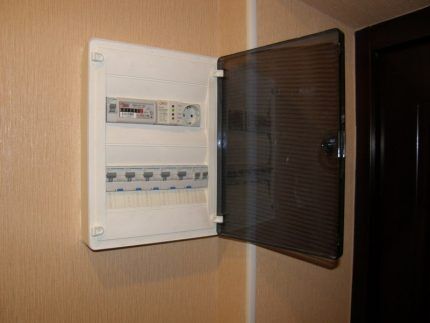
Typically, only the following type of equipment is installed in such a shield:
- introductory machine;
- electricity meter;
- circuit breakers, fuses and other control and protection devices;
- residual current devices;
- terminals, buses and other switching elements;
- elements of non-power networks, for example, for cable television;
- uninterruptible power supply units DC with remote batteries;
- control units for the “smart home” system.
A metal or plastic box protects the devices placed in it from physical impact, moisture and dust. Apartment panels located in the consumer's area of responsibility are not sealed so that the owner of the premises has access to circuit breakers. This procedure is carried out only for the counter.
The panels are equipped with a special profile made of plastic or galvanized metal - a DIN rail.All modular equipment, including meters, is mounted on them. This allows for compact and reliable placement of block equipment.
There are two types of electrical panels:
- Mounted. Their back wall is collapsible. It is removed and attached to the wall using self-tapping screws and dowels, and then the housing is put on. When choosing this option, you need to decide in advance on the location of the plant in the electrical wiring panel.
- Hidden installation. In this case, it is necessary to hollow out a niche under the shield.
When choosing a model, you must first make sure that there is enough space for all electrical system control components. It is better to take a shield with some reserve volume, since in the future it is possible to attach new automation.

If you need to install a switchboard outdoors, then there are special models for this that will protect the equipment from rain, snow, strong winds with dust and other natural phenomena.
We also recommend reading our other article, where we discussed in detail how to connect an electrical panel. More details - go to link.
The need for an introductory machine
The need to install an introductory machine and its rating can be specified in the contract for the provision of services for the supply of electricity. If there are no such requirements, then it is still better to use the machine.
The fact is that for installation and work with metering and control devices for electricity supply, it is necessary to de-energize the network. If the introductory machine is located on the consumer’s premises, then you can turn it off yourself.
Otherwise, turning off the electricity supply can only be done with the permission of the electricity supplier, and it will be necessary to call a specialist, since access to the general distribution boards by outsiders is prohibited.
This creates the following problems:
- it is necessary to agree on the shutdown time;
- if several consumers are connected to one switch, you will have to notify them of a temporary power outage;
- Calling a specialist in a non-emergency situation will cost money.
The time for carrying out all work when the electricity is turned off will be limited. Therefore, you need to immediately prepare the place, tools and perform preliminary steps that do not require a lack of power.
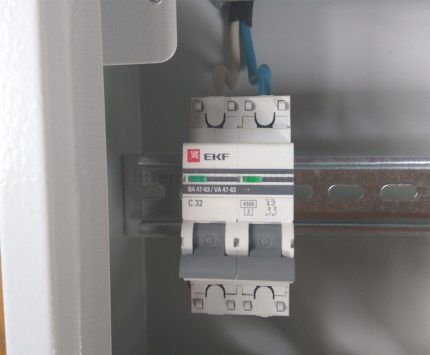
Therefore, before connecting the automation and single-phase electricity meter, it is better to install the input circuit breaker once than to negotiate this with electricians every time you need to work in your own electrical panel.
Modern electricity meters
Currently, electrified facilities have two types of meters: outdated electromechanical ones or new electronic ones. There are two main indicators for any type of electric meter.
The accuracy class (CT) determines the maximum permissible error in percent when measuring electricity. At the moment, there are classes of household meters (from lower to higher): “2.5”, “2.0”, “1.0”, “0.5” and “0.2”. According to clause 138 of the Government of the Russian Federation No. 442 of 05/04/2012, for individuals this parameter must be 2.0 or higher.
Therefore, when purchasing a device, there is no need to purchase models with a higher class, for example “0.5”. They are less popular and more expensive, so managers of trading companies often try to sell such devices to buyers unfamiliar with the topic.
The second important indicator is the maximum current that the device can pass through. For domestic and residential premises, this figure for a single-phase device cannot be more than 60 A.
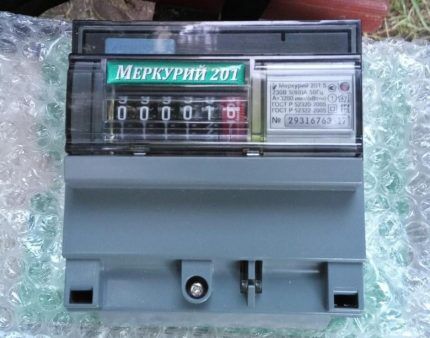
There are also multi-tariff meters that can be programmed to calculate electricity consumption at different daily periods.
Most metering devices are installed on a DIN rail in a distribution board. In this case, the model of the switchboard and meter must be selected in such a way that readings can be taken through the window without opening the door - this is very convenient.
A single-phase meter has 4 power terminals for connecting wires. Always, if you look at the device, then from left to right they go in the following order:
- Coming phase.
- Outgoing phase.
- Incoming neutral.
- Outgoing neutral.
Before starting installation work, it is necessary to de-energize the wires: turn off the incoming circuit breaker or switch, and also be sure to check that there is no voltage multimeter or an indicator screwdriver. And not only in phase, but also in neutral.
Both the meter and all automation are mounted on a DIN rail using the latches present on them.
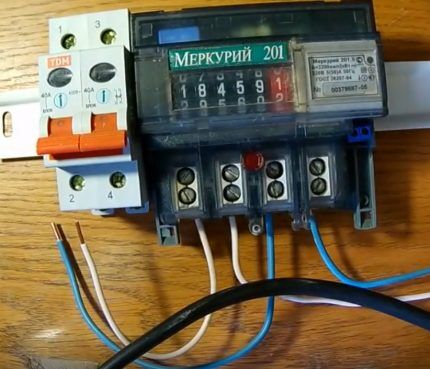
Next, you need to clean the wires that come from the input machine using insulation stripper or a stationery knife. The length of the segments should be such that they do not dangle, but are not tight either. The cleaned ends are inserted into the clamps and tightened with a screwdriver, and both screws must be properly tightened.
Circuit breakers and RCDs
With your own hands, you can connect not only an electricity meter, but also automatic machines that will protect the line and the meter from overload and short circuit.
All devices are also mounted on a DIN rail. The machines are connected only to the phase, and RCD – also to the neutral, which is output to the bus. It is advisable to leave a small space between the machines, since during operation they heat up, and air access from the sides helps with cooling.
The ground wire goes separately to its own bus. It does not go into the meter, as well as into machines and RCDs.
Conclusions and useful video on the topic
Equipping the panel with a meter, machines, socket and buses:
Assembling an apartment panel with your own hands:
Replacing or installing a single-phase electric meter yourself is quite simple. But when working with electricity, you must follow safety rules. Including not changing the sequence of devices in the connection diagram.
If you have the necessary knowledge and skills for connecting a single-phase electric meter, please share it with other visitors to our site. Tell us about the connection nuances that you know. Leave your comments and ask questions in the block below the article.




What happens if you confuse the phase with zero on the meter? It won't burn, how will it count?
I also heard that it is possible not to place a machine in the neutral wire before and after the meter, so as not to violate its integrity. Installing additional circuit breakers on the neutral wire will lead to additional leaks and voltage will drop when powerful electrical appliances are turned on.
I would be grateful for clarifications.
Good afternoon, Anton.
For clarification, I have attached a diagram of how the induction meter works. Briefly how it works:
— coils 4 and 3 create magnetic fields of a certain direction;
— the resulting magnetic field crosses the disk;
- currents induced by the field interact with it, causing rotation of the disk.
If you confuse the phase with zero, the directions of the fields and the direction of the current in the disk will change - the counter will begin to rewind the readings. True, the designers have provided for the possibility of error in the latest models by equipping the electric meters with a reverse stopper. As you can see, nothing will burn.
The situation with an electronic meter is different. I took a passport at random, single-phase, single-tariff CE101-R5. The instructions say that there is an indicator indicating “reverse power” (attached screenshot). In other words, the counter, if the phase and zero are mixed up, will warn that a mistake has been made. It turns out that it won’t burn either. If you are interested in other types of meters, I advise you to look at the passports.
How to install a meter and machines is written in the article. Don't use rumors.
If you change or confuse, as you say, the phase wire with the neutral wire. then nothing will happen. Except that it will be possible to steal electricity.Since the control of consumed electrical energy is carried out through the phase wire, and it, in turn, will be mistakenly connected in place of the neutral wire. When the meter is sealed, this is strictly monitored by the control personnel.